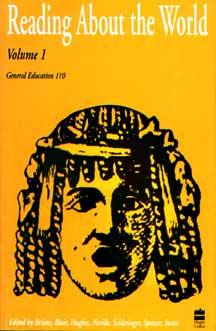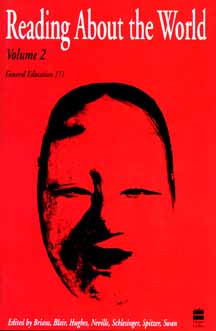 Reading About the World, Volume 1, edited by Paul Brians, Mary Gallwey, Douglas Hughes, Azfar Hussain, Richard Law, Michael Myers Michael Neville, Roger Schlesinger, Alice Spitzer, and Susan Swan.
Reading About the World, Volume 1, edited by Paul Brians, Mary Gallwey, Douglas Hughes, Azfar Hussain, Richard Law, Michael Myers Michael Neville, Roger Schlesinger, Alice Spitzer, and Susan Swan.
This anthology prints short selections sharply focussed on major topics of interest to beginning students of World Civilizations. It combines traditional historical sources with literary and philosophical selections.
By clicking on the hotlinks below you can access samples from Reading About the World, Volume 1. The third edition was published in 1999 by Harcourt Brace Custom Publishing.
- Mesopotamia
- Enuma Elish: The Babylonian Creation Epic
- The Epic of Gilgamesh: The Flood Story
- Three fragments describing evil spirits
- Sumer-Akkadian Hymn to Ishtar
- Hymn to the Moon God, Nanna
- The Code of Hammurabi, extracts
- Sumerian Proverbs
- Babylonian Proverbs
- Egypt
- Hymn to Sekhmet-Bast
- Hymn to Osiris
- Three Love Poems from the New Kingdom
- Dialogue of a Man With His Soul
- In Praise of Learned Scribes
- Hymn to the Aton of Akhnaton
- Japanese Poetry: from the Manyoshu and other early collections
- Imayo from the Heike Monogatari
- Various Japanese Poetry
- Lady Horikawa: Will he always love me?
- Kakinomoto Hitomaro: In the sea of ivy clothed Iwami
- Kakinomoto Hitomaro: I loved her like the leaves
- Lady Kasa: Six Tanka written for Otomo Yakamochi
- The Islamic World
- The Qur’an
- Sa’di: Story from the Gulistan
- Sufi Verse: Hafiz, Rumi
- Nizami: Layla and Majnun
- Ibn Hazm al-Andalusi: The Dove’s Necklace
- Wallada: To Ibn Zaidun
- Firdausi: The Struggle Between Esfandiyar and Goshtasp
- Usamah Ibn-Mundqidh: The Character and Customs of the Franks
- The European Middle Ages
- Hildegard of Bingen: Hymn to the Virgin
- Tommaso di Celano: Dies irae, dies illa*
- Stabat mater dolorosa
- The Wife’s Lament
- The Will of Wulfgyth
- Anna Comnena: The Alexiad
- Omittamus Studia from Carmina Burana
- La Comtessa de Dia: Estat ai en greu cossirier
- Provençal Dawn Song
- Dante Alighieri: The Inferno: Canto 3
- St. Thomas Aquinas: On Moral Principles & On Faith and Reason
- The Black Death: From The Chronicle ofJean de Venette
- Subsaharan Africa
- Bamba Suso: The Epic of Sunjata
- Ibn Battuta: Travels in Sub-Saharan Africa
- Pre-Columbian America
- The Popol Vuh: The Mayan Creation Story
- Aztec Birth Rituals for Boys and Girls
- Aztec Poetry
- Christopher Columbus: Letter to the King concerning his first voyage
*Selections marked are supplementary readings omitted from the 2nd edition of Reading About the World.
Reading About the World, Volume 2
Reading About the World is now out of print. You can search for used copies using the following information:Paul Brians, et al. Reading About the World, Vol. 1, 3rd edition, Harcourt Brace College Publishing: ISBN 0-15-567425-0 or Paul Brians, et al. Reading About the World, Vol. 2, 3rd edition, Harcourt Brace College Publishing: ISBN 0-15-512826-4.
Try Chambal:
http://www.chambal.com/csin/9780155674257/ (vol. 1)
http://www.chambal.com/csin/9780155128262/ (vol. 2)
All other queries should be directed to Paul Brians at paulbrians@gmail.com.
This is an excerpt from Reading About the World, Volume 1, edited by Paul Brians, Mary Gallwey, Douglas Hughes, Azfar Hussain, Richard Law, Michael Myers Michael Neville, Roger Schlesinger, Alice Spitzer, and Susan Swan and published by Harcourt Brace Custom Books.
General Education home page
Washington State University home page
paulbrians@gmail.com
 Reading About the World, Volume 2, edited by Paul Brians, Mary Gallwey, Douglas Hughes, Azfar Hussain, Richard Law, Michael Myers Michael Neville, Roger Schlesinger, Alice Spitzer, and Susan Swan.
Reading About the World, Volume 2, edited by Paul Brians, Mary Gallwey, Douglas Hughes, Azfar Hussain, Richard Law, Michael Myers Michael Neville, Roger Schlesinger, Alice Spitzer, and Susan Swan. Reading About the World, Volume 1, edited by Paul Brians, Mary Gallwey, Douglas Hughes, Azfar Hussain, Richard Law, Michael Myers Michael Neville, Roger Schlesinger, Alice Spitzer, and Susan Swan.
Reading About the World, Volume 1, edited by Paul Brians, Mary Gallwey, Douglas Hughes, Azfar Hussain, Richard Law, Michael Myers Michael Neville, Roger Schlesinger, Alice Spitzer, and Susan Swan.